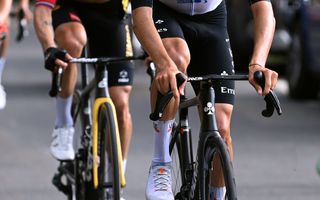'Only 3% of riders wanted an extreme brake lever position' - Adam Hansen on why riders voted for their own safety
“You have to draw a line and make it secure for everyone,” explains CPA president

Riders in the professional peloton voted against the use of extreme inward brake lever position, realising that the possible marginal aerodynamic gains were not worth the risk of crashing and serious injury.
In late December the UCI announced that so-called ‘extreme inward inclination’ would be restricted in 2024, with new regulations coming into force in 2025 after consultation with component manufacturers.
At the Tour Down Under UCI officials used a 3D printed tool to ensure riders had a maximum of 10 degrees of inward rotation on their levers, with teams forcing their riders to return to a more traditional position during the winter.
In recent years it has become fashionable to use narrower bars and turn the levers inwards to improve aerodynamics. However, that sparked a number of crashes and near crashes, with young riders emulating the professional despite not having the same level of bike skills.
“The riders are against the really extreme positions,” CPA president Adam Hansen explained to Rob Arnold of Ride Media in a video interview during the recent Tour Down Under.
“I did a survey with the riders at the Giro d’Italia where they think the brake levers should be. I gave them options of straight, five degrees, ten degrees and extreme. Only three per cent voted for the extreme position.
“Riders identified the problem and commented on it. There were a lot of crashes or close crashes.”
In his role as president of the CPA, Hansen speaks frequently to riders. He was also part of the new SafeR commission at the Tour Down Under that is working to improve safety at races. He described SafeR as a ‘kind of like anti-doping for race organiser’, with the major stakeholders from the sport studying why major crashes occurred and what can be done to improve race safety.
Hansen is fully aware of the dangers of extreme lever positions.
“I have eyes in the peloton, who see the crashes that almost happen and that’s really useful info,” he said.
“It’s not because of the lever position per se, it’s when the riders have to brake. On the hoods (with levers in an extreme position) you can’t reach the brakes properly. You have to rotate your wrist and by the time you do that, it’s too late.”
Hansen is also part of the UCI Equipment Commission, representing the riders, and so understands that ‘extreme inward inclination’ levers can lead to damage to carbon handlebars and so potential crashes.
The consequences of UCI rules are often seen at professional races but can affect everyone who races or rides a bike.
“You have to draw a line and make it secure for everyone,” Hansen pointed out.
“The UCI said that 16-year-olds all turned their brake levers inwards because the pros did. We’ve got to avoid that, so we not only do safety amongst the pros but for everyone.
“I’ve worked with (Head of Road & Innovation) Michael Rogers at UCI. He found out that the handlebars weren’t designed to have the lever positioned like that, so there were some cracks on the handlebars.
“What made it worse, the cracks were at the bottom of the brake lever’s metal wrap that goes around the handlebar. So if you stand on the pedals and sprinting uphill, you put heaps of load on it and that can create cracks you don’t know about. Then at the end of the race, when you're sprinting in the drops, you’re holding the bars under the crack. That could lead to a fatal accident.”
“The UCI did an investigation and realised that there were greater stress points the more the levers were turned inwards. The handlebars are just not designed for it. That’s why the UCI took action.”
Thank you for reading 5 articles in the past 30 days*
Join now for unlimited access
Enjoy your first month for just £1 / $1 / €1
*Read any 5 articles for free in each 30-day period, this automatically resets
After your trial you will be billed £4.99 $7.99 €5.99 per month, cancel anytime. Or sign up for one year for just £49 $79 €59
Join now for unlimited access
Try your first month for just £1 / $1 / €1
Get The Leadout Newsletter
The latest race content, interviews, features, reviews and expert buying guides, direct to your inbox!

Stephen is the most experienced member of the Cyclingnews team, having reported on professional cycling since 1994. He has been Head of News at Cyclingnews since 2022, before which he held the position of European editor since 2012 and previously worked for Reuters, Shift Active Media, and CyclingWeekly, among other publications.
